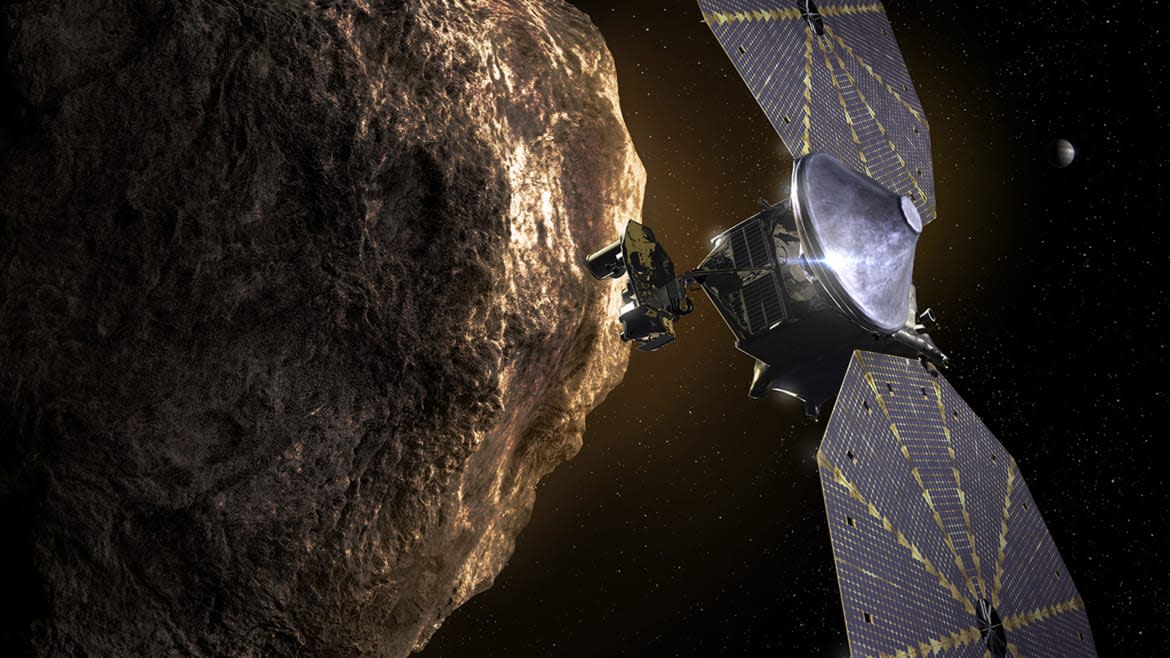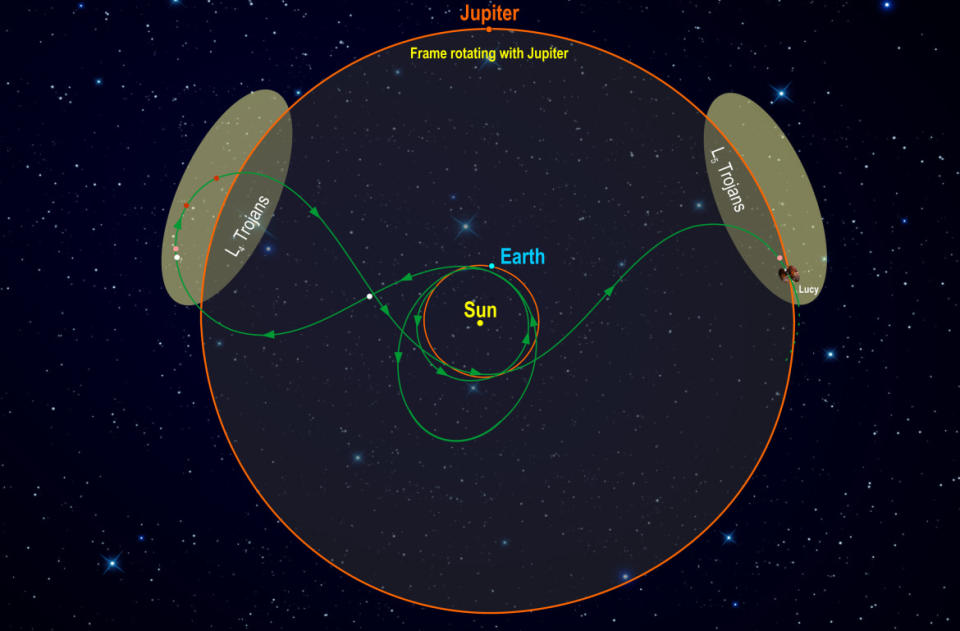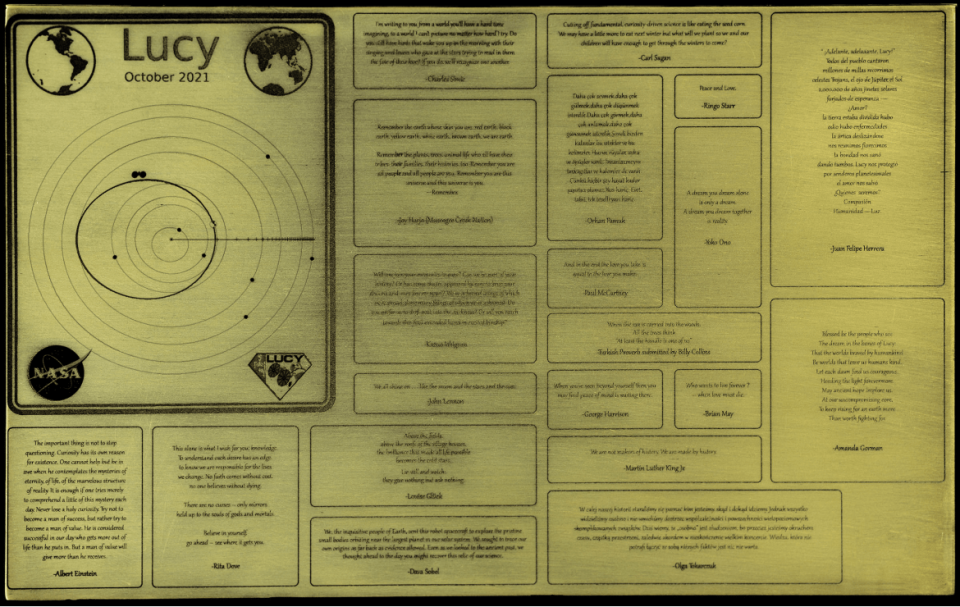NASA's Newest Probe Will Visit Grizzled Asteroids to Search for Solar System's Secret Origins

In eight days, if everything goes according to plan, NASA is going to launch a high-tech probe on a 12-year mission to visit two separate patches of ancient space rocks looping around the sun in the inky dark, 530 million miles from Earth.
The goal of the Lucy mission is simple: get close enough to eight of the so-called “Trojan asteroids” to snap photos and beam them back to NASA. Those images could verify long-held suspicions by scientists that the Trojan asteroids are peppered with organic material—the building blocks of life.
Lucy’s flybys are tricky, to say the least. Two clusters of Trojan asteroids accompany Jupiter in its wide orbit around the sun. One cluster travels ahead of Jupiter. The other trails behind. Getting a single spacecraft close enough—600 miles or so—to scan the asteroids requires a mind-boggling series of maneuvers. The whole scheme demands perfect timing.
NASA plans to launch the 52-foot Lucy with its wing-like, extendable solar panels from Cape Canaveral Space Force Station in Florida on Oct. 16. In space, it will sprint around Earth in order to build up energy, then it will fling itself to the Trojans in front of Jupiter. After a leisurely cruise through this first asteroid patch, Lucy will fire its thrusters, speed back to Earth, loop around to pick up even more energy, then arc outward to the asteroid patch behind Jupiter. NASA describes it as a bizarre “pretzel-like” trajectory.
Can Venus Help Save Earth From ‘Going Jeffrey Dahmer’? NASA’s Going to Find Out
If it works, Lucy—named for the fossilized skeleton of an early hominid found in Ethiopia in 1974, which itself was named after the famous Beatles song—could give us new insight into the formation of the solar system, 4.5 billion years ago. It might even help us understand where all Earth life came from.
NASA dreamed up the Lucy mission in 2017. Officials realized that the complex clockwork of the solar system (planets and asteroids orbiting the Sun at different rates) gave the agency a chance to sling a single spacecraft in two directions in order to inspect a whole bunch of different asteroids in one long go.
“Lucy’s awesome trajectory, that takes it three-and-a-half times around the sun with three Earth gravity assists to six encounters with eight asteroids, is more than anything else a fantastic opportunity,” Tom Statler, a Lucy program scientist, told The Daily Beast.
Planners knew approximately how big they could make the probe, how much fuel it could carry for its thrusters and how much power its solar panels might generate. They also knew, from telescope surveys, which of the thousands of Trojan asteroids are most interesting from a scientific perspective.
The trick was balancing the size, complexity and cost of the probe against the value of the data it might gather. “The Lucy trajectory certainly was challenging,” Kevin Berry, who’s in charge of the Lucy program’s flight dynamics, told The Daily Beast.
The Lucy team picked two of the most promising Trojan asteroids as a starting point. After that, a Lockheed Martin engineer named Brian Sutter crunched the numbers, examining countless permutations of a multi-billion-mile journey.
“Each additional target required an adjustment to the flight path, which carried a cost of additional propellant,” Berry said. “Analyzing various combinations of targets while minimizing the total propellant was a very laborious task, but we were lucky enough to find a diverse sample of Trojans that we could encounter.”

Lucy's intended trajectory will require multiple passes around Earth and the Sun as it moves between two groups of asteroids.
Once it knew where Lucy should go, NASA could develop the actual probe. The agency tapped Lockheed for the nitty-gritty work. After four years and a billion dollars, the result is a sprawling spacecraft that’s tasked with visiting at least eight different asteroids.
Lucy has a compact central body, to which are attached fuel tanks, maneuvering thrusters and antennae. The cameras jut from the top of the spacecraft. A pair of solar panels, each 24 feet across, fan out from the middle.
Because Lucy flies both close to and far from the Sun during its decade-plus journey, it needs to withstand both the freezing cold of space, and the very freezing cold of space, Statler pointed out. So it’s built tougher than many probes.
The sensors are the whole point of the enterprise. Lucy carries three main cameras, all solar-powered. The biggest is a high-resolution black-and-white camera called L’Lorri that borrows its basic design from the Hubble Space Telescope.
L’Lorri is impressive. “From 600 miles away, for example, L’Lorri will be able to spot surface features as small as 45 feet across, detailed enough to help the team understand the asteroids’ surface geology,” Hal Weaver, a Johns Hopkins Applied Physics Laboratory scientist who is the principal investigator for the camera, told The Daily Beast.
“L’Lorri can also spot rings, satellites or dusty activity, and its ability to see faint targets from far away also makes it perfect for optical navigation, producing images the mission operations team will use to navigate Lucy to a point in space,” Weaver added.
In addition to L’Lorri, Lucy also packs an infrared camera for registering the heat, or lack thereof, in the asteroids—and a multi-spectral camera that can detect those intriguing organic compounds.
Those possible organic compounds might be the biggest, and rarest, prize. “Generally speaking, the Jupiter Trojans are very different from the ones we find closer to home,” Niels F.W. Ligterink, a planetary scientist at the University of Bern, told The Daily Beast.
The asteroids closer to Earth mostly consist of minerals or coal-like carbonaceous material. In other words, they’re dead. The Trojans, by contrast, might be teeming with the raw materials that, with time and the proper chemistry, can evolve into bacteria and bugs and dogs and people.
Scientists suspect the Trojans harbor organic compounds because, in telescopes, they appear red, Ligterink explained. “This red color indicates that organic molecules are present on their surfaces. This is probably a complex cocktail of molecules, but this cocktail might contain the building blocks of life, such as amino acids.”
Lucy’s planned mission ends in 2033 when its fuel runs out. But the probe itself, by then cold and silent, will continue looping in and out of the solar system, potentially for millions of years. Because there’s a small chance that Lucy outlives the human race, NASA bolted a plaque onto the spacecraft with messages to alien explorers.
The plaque includes inspirational quotations from famous scientists, activists, musicians and poets including Albert Einstein, Martin Luther King, Jr., George Harrison and Rita Dove.

The plaque that Lucy is going to carry on its journey to the Trojan asteroids.
Einstein’s blurb in particular seems like a commentary on the Lucy mission itself. “The important thing is not to stop questioning,” it reads. “Curiosity has its own reason for existence. One cannot help but be in awe when he contemplates the mysteries of eternity, of life, of the marvelous structure of reality.”
Get our top stories in your inbox every day. Sign up now!
Daily Beast Membership: Beast Inside goes deeper on the stories that matter to you. Learn more.

